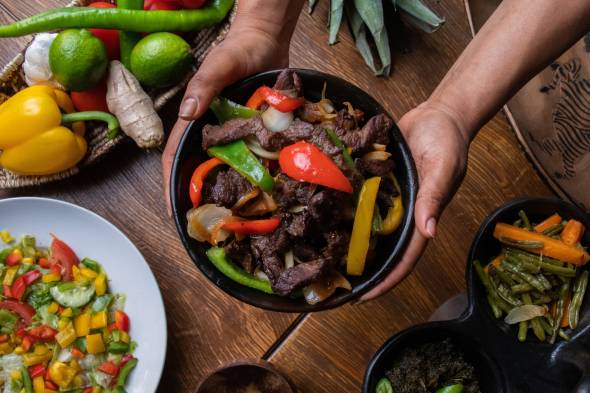Amazing Food Habits from Across the World
Although the United States does not have the highest rate of obesity in the Americas (that honor goes to Mexico), more than one-third of all adults in the U.S. are fat, and the rate isn’t going down anytime soon. It’s a startling figure, especially when contrasted to data from nations like Japan and India, where obesity levels are much below 5%.
Why is there a contrast? A variety of factors influences obesity rates, but it all comes down to what individuals eat and how they consume it. The good thing is that healthy eating habits can be borrowed from countries worldwide, while less nutritious ones may be left on foreign territory.
1. Japan
What’s a surprising Japanese habit to adopt? The focus is on the look of the food. A visually appealing—and healthy—plate combines small amounts with colorful, seasonal vegetables. Small servings keep calories down, while veggies deliver a variety of vitamins and minerals. Skip eating fishes like tuna, king mackerel, and swordfish. They contain mercury, an element that can damage nerve cells. Rather than maguro (tuna) and nama-saba (mackerel), consume sake (salmon), Ebi (shrimp), and ika (squid).
Another beneficial Japanese habit is the practice of hara hachi bu, which means eating until you are 80% full. This tradition, originating from Okinawa, encourages mindfulness and helps prevent overeating. Additionally, incorporating more fermented foods like miso, natto, and pickled vegetables can improve gut health due to their probiotic content. Traditional Japanese meals often include a variety of small dishes, allowing for diverse flavors and nutrients in one sitting, which can lead to a more balanced and satisfying diet. By adopting these habits, you can enhance both the enjoyment and nutritional value of your meals.
2. China
Grip chopsticks: Chopsticks will help you eat more slowly, which means you’ll eat less. Moreover, studies have shown that people who consume more quickly are more prone to be fat and suffer from heart disease. Orange chicken should be avoided (and other Americanized Chinese food). You should not consume meat that’s been coated in sweet sauce (which is why it tastes so nice). Instead, go for lo mein or stir-fry dishes.
Incorporating traditional Chinese food practices can further enhance your dining experience. Chinese cuisine often emphasizes balance and variety, with a focus on fresh vegetables, lean proteins, and whole grains. Ingredients like ginger, garlic, and green onions not only add flavor but also offer health benefits, such as boosting the immune system and improving digestion. Drinking tea, especially green or oolong tea, during meals is another common practice that aids digestion and provides antioxidants. By embracing these authentic elements of Chinese dining, you can enjoy a more nutritious and flavorful meal.
3. USA
The United States offers a diverse culinary landscape, heavily influenced by a mix of cultures and traditions from around the globe. One prominent aspect of American eating habits is the preference for convenience food. Fast food restaurants and pre-packaged meals are a significant part of the American diet. These options are popular due to their affordability and time-saving attributes. However, they often come with high levels of sugar, salt, and unhealthy fats, contributing to the country’s high obesity rates. On the flip side, there is a growing trend towards organic and farm-to-table dining, with many Americans becoming more conscious about their food choices and opting for fresher, locally sourced ingredients.
Another notable food habit in the USA is portion size. Serving sizes in American restaurants and at home are generally larger than those found in many other countries. This tendency towards larger portions can lead to overeating and plays a significant role in calorie consumption and weight gain. Tourists traveling to Sin City, as well as residents, love checking out area15 Las Vegas The Beast which is well known for its fair portions and authentic American food. Nonetheless, there is a rising awareness around portion control, with some restaurants offering smaller plate options and individuals practicing mindful eating to better manage their food intake. Amidst these habits, the unique element of American dining culture is its adaptability and innovation, continuously evolving to incorporate healthier eating practices while retaining its rich and varied culinary heritage.
4. France
Tempt your taste buds: According to one study, the French equate eating with pleasure (rather than health), and the nation has less obesity and heart disease levels than the United States. Americans, however, are more worried about how nutritious their food is, yet they enjoy eating less. Instead of a big section of a “healthy” snack like frozen yogurt, try a little amount of a delicacy you enjoy (a rich, dark chocolate nugget fits the bill) and enjoy the senses.
The regular pastry should be avoided. Much like most buttery morning pastries, a choco croissant is high in simple carbs, sugar, and fats (a.k.a. not a great start to the day). Over most days, go for healthier options like oatmeal or yogurt, and reserve the pastry for special occasions.
5. Ethiopia
The classic Ethiopian flatbread injera is abundant in fiber, Vit C, and protein. Root vegetables, legumes, and lentils are essential in the Ethiopian diet, low in milk and animal products. Make your injera or use teff grains instead of rice in a rice alternative.

This dish is best served as a family meal. Shared foods are picked up with injera in the typical Ethiopian diet. Put individual servings on a plate to make it simpler to see how much you’re consuming while eating this way.
6. India
Spice things up. Indian food has a lot of spices, which give them a lot of taste, a lot of colors, and a lot of healing properties. Turmeric, ginger, and red pepper are some of the spices that may help decrease cholesterol. Onions and garlic, which are commonly used flavorings, can also help to reduce your risk of heart problems.
Creamy sauces should be avoided. Several recipes have an unusually high saturated fat content thanks to ghee (clarified butter) and full-fat coconut milk. Ease up on the rich dishes if you’re trying to prevent or limit saturated fat in your diet. Instead, opt for tandoori-grilled meat and tomato-based soups.
7. Mexico
Enjoy your lunch: Almuerzo, a lunchtime meal that is the largest meal of the day, is a part of the traditional Mexican culture. According to recent research, eating a good dinner in the evening may be a major contributor to weight gain.
Refried beans are a no-no. Beans have lots of protein, fiber, and vitamins. Cooking them in butter or oil, on the other hand, greatly increases the calories. For a healthier burrito, use dried or low-sodium canned beans.
8. Italy
Dine and Drink: Have a glass of wine with your meal, but don’t overdo it. Moderate alcohol consumption—one glass a day for women and two glasses per day for men—has been shown in studies to lower your risk of heart disease and prolong your life. For non-alcoholics, you can have your preferred beverage in glass bottles for juice.

Pasta plates should be avoided. For otherwise fit Italians, a pasta-heavy meal has been found to raise heart disease risk. Replace spaghetti squash for ordinary noodles and serve a veggie-rich soup for a healthier take on Italian night.
9. Greece
The medical benefits of the Mediterranean diet are no longer a secret. Classic Mediterranean food mainly consists of fruits, vegetables, cereals, and legumes, with only trace amounts of protein, fish, milk, and olive oil. You can also consume bottled and jarred packaged goods.
Phyllo flour should be avoided. We know that spanakopita is loaded with spinach, but the buttered pastry is loaded with refined carbs. A normal entrée-size dish of spanakopita can have the same amount of fat as a bacon cheeseburger!
10. Sweden
Although Scandinavian food does not include many vegetables, it does contain several healthy items. Rye bread is basic, and it has a lot of fiber, which will keep you feeling full. For a fiber-rich option to white or whole-wheat bread, make a sandwich on rye.
Avoid Salt, mainly if you’re prone to high blood pressure. Traditional Nordic meals, such as smoked salmon, are high in salt. As an option, try preparing your smoked fish—still, it’s delicious but helps maintain the sodium under control.
The Bottom Line
There is no such thing as a universally healthy (or harmful) diet. However, the meals of places with cheaper rates of chronic illness have a few traits. All stress the need to eat lots of fruits, veggies, grains, and healthy fats and enjoy your meals.
Turn to different cuisines for culinary ideas, new flavors and ingredients, and diverse eating habits. Combine aspects from these many diets to build your form of healthy eating.




